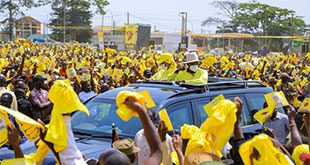
Kampala, Uganda | THE INDEPENDENT | Khisa Isaac | Buziga is situated on the edge of Munyonyo, an address of some of Kampala’s affluent class. Buziga is an upscale suburb populated by gated storied residential houses.
But during 2016 presidential election, a polling station in this area—Upper Buziga Community Center—had the highest number of invalid votes in the country, according to analysis of election results data.
The polling station was located just opposite Kabojja International School. Astonishingly, 300 out of 597 votes cast at this polling station, representing over 50 percent.
Residents of the Buziga who voted at this polling station interviewed recalls that voting materials arrived in the afternoon, voting was a hasty exercise that extended to night hours, necessitating those who voted at night to either cast vote with aid of the phone lights or vote in total darkness. Residents say this might have been the cause of high number of invalid votes.
Eddy Mubiru’s home is adjacent the polling station and was present during the counting. He said people were ticking more than one candidate while for those who used thumb-prints, ink would spread to the next candidate. (vox pop: Eddy Mubiru and Siraje Kasita explains what transpired on voting day).
Robert Nyanzi, who served as an Electoral Commission parish supervisor of Buziga Parish in 2016 said in a phone interview, “they (people) were voting anyhow. The problem was, you would tell people what to do and they do opposite.” He had initially accepted a face to face interview but later declined.
Ticking more than one candidate is an invalid vote but when ink spread to another candidate, it supposed to be a valid vote, several experts on election management said because the voter intention is clear. These two were top most attributes of invalid votes according to a study conducted by Electoral Commission in 2019, Cyprian Ogwang, the head of Research and Planning at the commission.
The study districts were selected randomly, Ogwang said, focusing on rural and urban areas. For urban areas, it was conducted in Kampala and Wakiso, while Katakwi, Kamuli, Butaleja, Lira, Bushenyi and Kasese were for rural areas. The analysis that informed this story sorted results of 28,010 polling stations gazetted by the Electoral Commission in the 2016 presidential election to identify polling stations that registered the highest numbers of invalid votes.
Second to Upper Buziga Community Center was Bweranga (N-Z), a polling station found in Katabi, Wakiso district with 265 out of 538 cast votes invalid, representing 49 percent of total votes. But residents vehemently dispute this data. They say they did not have this high number of invalid votes.
“That is not true because we had less than 30 invalid votes, my people know what to do,” Emoit Joseph, area Local Council I chairman said.
Also dismissing the results announced by he Electoral Commission as false, Heinlein Nyondo who voted for President Yoweri Museveni at this polling station said Forum for Democratic Change (FDC) candidate Dr. Kizza Besigye did not score two votes as recorded in Electoral Commission data. “I don’t support Besigye but he got over 100 votes because he had many supporters in this village,” she said.
The efforts to locate the presiding officer of this polling station were futile. Resident said the presiding officers had not picked from their locality.
The Electoral Commission spokesperson Paul Bukenya said 49 percent of votes being invalid “is outrightly on the high side.” Bukenya says he has no chance to look at data of four years ago. And in the middle of another election, access to statistics or engaging the returning officer is hard. “This is a matter that needs to be followed to obtain more insights,” he said.
Then protest votes
Ogwang said there were instances of protest votes as voter passionately and markedly expressed dislike of certain candidates. He illustrates: “Someone would write on the ballot paper; this candidate is fake: this candidate is Satan. That is a sign of protest vote. There were also blank votes. A blank vote can be a protest vote or as result of a voter being ignorant that he or she is supposed to tick or thumb-print their preferred choice.
But Peter Bogere, a civic education project coordinator at Uganda Project Implementation and Management Centre (UPIMAC), an organization that designed voter education modules ahead of 2016 elections said a blank vote is more of misinterpretation of instructions than protest vote.
“You have people who when told by a presiding officer to fold the ballot after voting just fold it there and then. I assume this is misinterpretation,” Bogere said.
Bogere argues that some voters genuinely don’t understand how to vote. He attributes the problem of invalid votes to presiding officers who get swayed by voters during vote counting. These presiding officers end up making mistakes: counting valid as invalid votes.
Apart from Bwerenga and Buziga polling stations, the other polling stations that feature in top ten with high number of invalid votes are in Karamonga region in Napak and Kaabong districts. Equally, the districts that had the highest percentage of invalid votes in 2016 were in Karamonga.
The number of invalid votes in 2016 presidential elections—477,319 representing 4.62 percent—was far above the total votes of six candidates; Abed Bwanika, Amama Mbabazi, Baryamureba Venansius, Benon Biraro, Mabirizi Joseph and Maureen Kyalya. Their combined score was the equivalent to 3.77 percent. Invalid votes are a problem that has been snowballing for more than two decades. For instance, the percentage of invalid votes has almost doubled from 2.5 of 2001 presidential election results.
There is lack of granular data of Member Parliament election results that can be based on to examine whether patterns of invalid votes in presidential elections extend to parliamentary election results at same polling stations.
Invalid votes is a complex problem that requires a deeper study. It may require the Electoral Commission to examine polling stations with high number of invalid votes after 2021 elections rather than a random selection of districts/polling stations. Ogwang said the law permits the commission to open ballot boxes six months after elections.
People seems to understand how to cast a valid vote. For instance, from Karamoja to Kampala, about 20 voters interviewed in areas that had the highest number of invalid votes ably distinguished a valid from an invalid vote. (Lokuta from Napak district and Eddy Mubiru from Kampala explains their understanding of a valid vote.)
More and more voter education
The panacea, people say is more civic education. And people, especially in Karamoja think that educated voters understand how to vote than the uneducated.
“Those who have been to school understand what to do,” Mary Acam of Naligoi Village, Lokupoi Parish in Matany Sub County Napak said.
Ogwang said the study they conducted recommended extensive voter education of both electoral officials and voters.
Ahead of 2020, such voter education would however be expensive and limited by coronavirus restrictions of mass gathering. Voter education that target areas that had highest number of invalid votes would be appropriate.
To curb valid votes that usually end up being counted as invalid, Bogere of UPIMAC says, “It is the role of the people in charge of managing election to interpret the choice of the voter. And It’s a failure on the side of the polling official if they fail to interpret the choice of the voter.”
Bogere explained a scenario, for instance, what if a voter doesn’t know how to read the name of the candidate but only knows the photo. Such a voter will tick or thumb-print on the photo. The intention of that voter is clear. So it’s a valid vote.
Stanley Ebele contributed to this reporting
********
URN
 The Independent Uganda: You get the Truth we Pay the Price
The Independent Uganda: You get the Truth we Pay the Price





